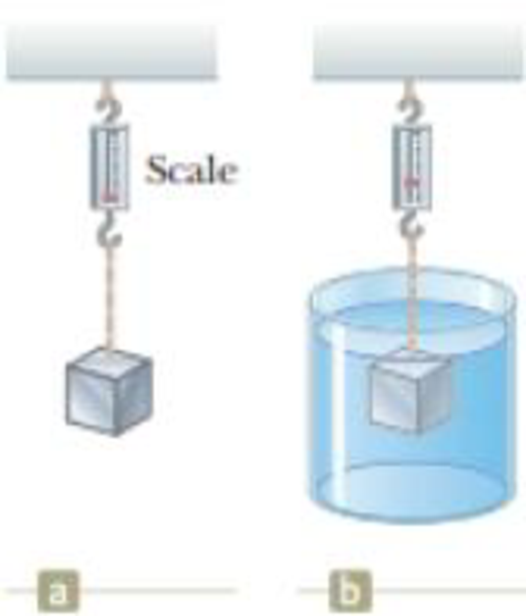
Concept explainers
A 10.0-kg block of metal measuring 12.0 cm by 10.0 cm by 10.0 cm is suspended from a scale and immersed in water as shown in Figure P14.11b. The 12.0-cm dimension is vertical, and the top of the block is 5.00 cm below the surface of the water. (a) What are the magnitudes of the forces acting on the top and on the bottom of the block due to the surrounding water? (b) What is the reading of the spring scale? (c) Show that the buoyant force equals the difference between the forces at the top and bottom of the block.
Figure P14.11 Problems 11 and 12.

(a)
The magnitudes of the forces acting on the top and on the bottom of the block due to the surrounding water.
Answer to Problem 27P
The magnitudes of the forces acting on the top and on the bottom of the block due to the surrounding water is
Explanation of Solution
Section 1:
To determine: The magnitudes of the force acting on the top of the block due to the surrounding water.
Answer: The magnitudes of the force acting on the top of the block due to the surrounding water is
Given information:
The mass of the block is
Formula to calculate the absolute pressure at the top of the block is,
Formula to calculate the force acting on the top of the block is,
Substitute
Substitute
Conclusion:
Therefore, the magnitudes of the force acting on the top of the block due to the surrounding water is
Section 2:
To determine: The magnitudes of the force acting on the bottom of the block due to the surrounding water.
Answer: The magnitudes of the force acting on the bottom of the block due to the surrounding water is
Given information:
The mass of the block is
Formula to calculate the absolute pressure at the bottom of the block is,
Formula to calculate the force acting on the bottom of the block is,
Substitute
Substitute
Conclusion:
Therefore, the magnitudes of the force acting on the bottom of the block due to the surrounding water is
(b)
The reading of the spring scale.
Answer to Problem 27P
The reading in the spring scale is
Explanation of Solution
Given information:
The mass of the block is
The scale reading when the block is immersed in water is equal to the tension in the chord supporting the block.
Apply the equilibrium condition.
Rearrange the above equation for
Substitute
Conclusion:
Therefore, the reading in the spring scale is
(c)
To show: That the buoyant force equals the difference between the force at the top and bottom of the block.
Explanation of Solution
Given information:
The mass of the block is
When an object is immersed in a liquid, then the upward force exerted on it by fluid is called buoyant force and its magnitude equals the weight of the liquid displaced by the object.
Formula to calculate the buoyant force is,
Substitute
From part (a), the difference between the force at the top and bottom of the block is,
From the above calculations it is clear that,
Conclusion:
Therefore, the buoyant force equals the difference between the force at the top and bottom of the block.
Want to see more full solutions like this?
Chapter 14 Solutions
Physics for Scientists and Engineers with Modern Physics Technology Update
- A 10.0-kg block of metal measuring 12.0 cm by 10.0 cm by 10.0 cm is suspended from a scale and immersed in water as shown in Figure P14.11b. The 12.0-cm dimension is vertical, and the top of the block is 5.00 cm below the surface of the water. (a) What are the magnitudes of the forces acting on the top and on the bottom of the block due to the surrounding water? (b) What is the reading of the spring scale? (c) Show that the buoyant force equals the difference between the forces at the top and bottom of the block. Figure P14.11 Problems 11 and 12.arrow_forwardMercury is poured into a U-tube as shown in Figure P15.17a. The left arm of the tube has cross-sectional area A1 of 10.0 cm2, and the right arm has a cross-sectional area A2 of 5.00 cm2. One hundred grams of water are then poured into the right arm as shown in Figure P15.17b. (a) Determine the length of the water column in the right arm of the U-tube. (b) Given that the density of mercury is 13.6 g/cm3, what distance h does the mercury rise in the left arm?arrow_forwardAn incompressible, nonviscous fluid is initially at rest in the vertical portion of the pipe shown in Figure P15.61a, where L = 2.00 m. When the valve is opened, the fluid flows into the horizontal section of the pipe. What is the fluids speed when all the fluid is in the horizontal section as shown in Figure P15.61b? Assume the cross-sectional area of the entire pipe is constant. Figure P15.61arrow_forward
- Review. The lank in Figure P14.15 is filled with water of depth d = 2.00 m. At the bottom of one sidewall is a rectangular hatch of height h = 1.00 m and width w = 2.00 in that is hinged at the top of the hatch, (a) Determine the magnitude of the force the water exerts on the hatch, (b) Find the magnitude of the torque exerted by the water about the hinges.arrow_forwardReview. The tank in Figure P15.13 is filled with water of depth d = 2.00 m. At the bottom of one sidewall is a rectangular hatch of height h = 1.00 m and width w = 2.00 m that is hinged at the top of the hatch. (a) Determine the magnitude of the force the water exerts on the hatch. (b) Find the magnitude of the torque exerted by the water about the hinges.arrow_forwardA fluid flows through a horizontal pipe that widens, making a 45 angle with the y axis (Fig. P15.48). The thin part of the pipe has radius R, and the fluids speed in the thin part of the pipe is v0. The origin of the coordinate system is at the point where the pipe begins to widen. The pipes cross section is circular. a. Find an expression for the speed v(x) of the fluid as a function of position for x 0 b. Plot your result: v(x) versus x. FIGURE P15.48 (a) The continuity equation (Eq. 15.21) relates the cross-sectional area to the speed of the fluid traveling through the pipe. A0v0 = A(x)v(x) v(x)=A0v0A(x) The cross sectional area is the area of a circle whose radius is y(x). The widening pan of the pipe is a straight line with slope of 1 and intercept y(0) = R. y(x) = mx + b = x + R A(x) = [y(x)]2 = (x + R)2 Plug this into the formula for the velocity. Plug this into the formula for the velocity. v(x)=A0v0(x+R)2arrow_forward
- Figure P15.47 shows a stream of water in steady flow from a kitchen faucet. At the faucet, the diameter of the stream is 0.960 cm. The stream fills a 125-cm3 container in 16.3 s. Find the diameter of the stream 13.0 cm below the opening of the faucet. Figure P15.47arrow_forwardThe inside diameters of the larger portions of the horizontal pipe depicted in Figure P9.45 are 2.50 era. Water flows to the right at a rate of 1.80 104 m3/s. Determine the inside diameter of the constriction. Figure P9.45arrow_forwardThe gravitational force exerted on a solid object is 5.00 N. When the object is suspended from a spring scale and submerged in water, the scale reads 3.50 N (Fig. P15.24). Find the density of the object. Figure P15.24 Problems 24 and 25.arrow_forward
- A wooden block floats in water, and a steel object is attached to the bottom of the block by a string as in Figure OQ15.1. If the block remains floating, which of the following statements are valid? (Choose all correct statements.) (a) The buoyant force on the steel object is equal to its weight. (b) The buoyant force on the block is equal to its weight. (c) The tension in the string is equal to the weight of the steel object. (d) The tension in the string is less than the weight of the steel object. (e) The buoyant force on the block is equal to the volume of water it displaces.arrow_forwardA beaker of mass mb containing oil of mass mo and density o rests on a scale. A block of iron of mass mFe suspended from a spring scale is completely submerged in the oil as shown in Figure P15.63. Determine the equilibrium readings of both scales. Figure P15.63 Problems 63 and 64.arrow_forward
 Physics for Scientists and EngineersPhysicsISBN:9781337553278Author:Raymond A. Serway, John W. JewettPublisher:Cengage Learning
Physics for Scientists and EngineersPhysicsISBN:9781337553278Author:Raymond A. Serway, John W. JewettPublisher:Cengage Learning Physics for Scientists and Engineers with Modern ...PhysicsISBN:9781337553292Author:Raymond A. Serway, John W. JewettPublisher:Cengage Learning
Physics for Scientists and Engineers with Modern ...PhysicsISBN:9781337553292Author:Raymond A. Serway, John W. JewettPublisher:Cengage Learning Principles of Physics: A Calculus-Based TextPhysicsISBN:9781133104261Author:Raymond A. Serway, John W. JewettPublisher:Cengage Learning
Principles of Physics: A Calculus-Based TextPhysicsISBN:9781133104261Author:Raymond A. Serway, John W. JewettPublisher:Cengage Learning Physics for Scientists and Engineers, Technology ...PhysicsISBN:9781305116399Author:Raymond A. Serway, John W. JewettPublisher:Cengage Learning
Physics for Scientists and Engineers, Technology ...PhysicsISBN:9781305116399Author:Raymond A. Serway, John W. JewettPublisher:Cengage Learning Physics for Scientists and Engineers: Foundations...PhysicsISBN:9781133939146Author:Katz, Debora M.Publisher:Cengage Learning
Physics for Scientists and Engineers: Foundations...PhysicsISBN:9781133939146Author:Katz, Debora M.Publisher:Cengage Learning College PhysicsPhysicsISBN:9781285737027Author:Raymond A. Serway, Chris VuillePublisher:Cengage Learning
College PhysicsPhysicsISBN:9781285737027Author:Raymond A. Serway, Chris VuillePublisher:Cengage Learning





